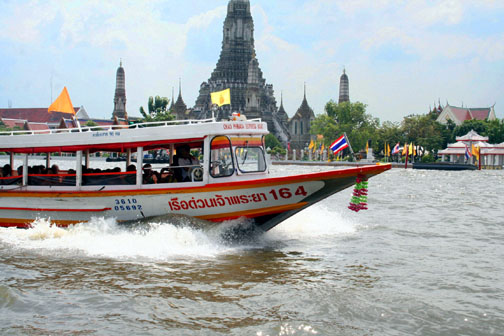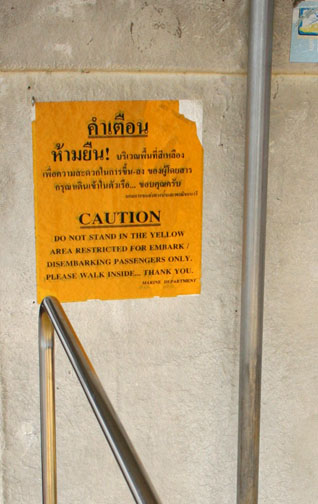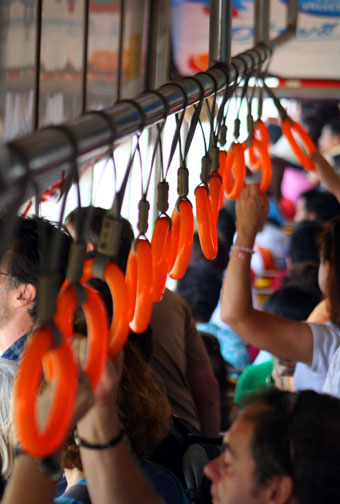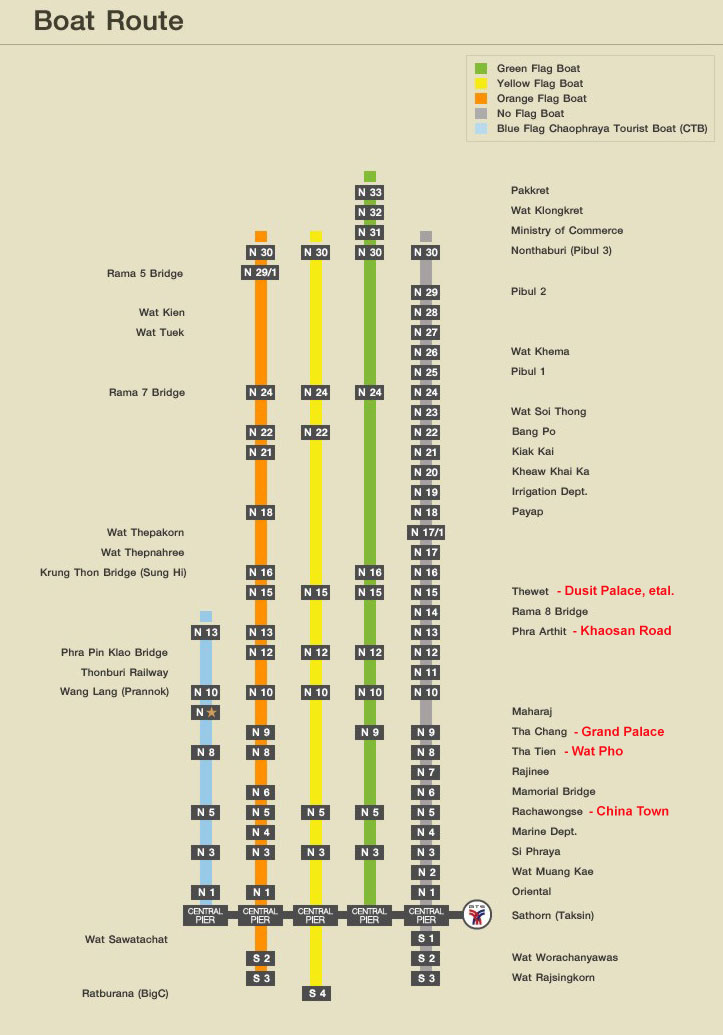One of the cheaper thrills in Bangkok is riding the riverboats servicing the Chao Phraya River. They are a convenient transportation option for any destination along the river too. The process of catching one of the boats can be a bit daunting to the first time visitor; the internet is awash with warnings about having to hop on and hop off quickly, one type going along the river and another across it, boats that don’t stop at all piers . . . it’s easier to just decide to take a taxi instead. Ignore all that crap (but pay attention to the few warnings I’m about to provide) and go for it. You’ll enjoy the trip, the views, and how little the experience costs.
The most frequent route touri take is up from the Central Pier to where the Grand Palace and Wat Pho are. I know some old hands claim it’s better to make that trip by taxi as it’s quicker. But you’re on holiday. It’s time to slow down a bit. And in this case it really is more about the journey than the destination. Taking a riverboat to the Grand Palace means your experience starts at dockside. You’ll remember your boat ride. A ride in a taxi, not so much.
Getting Started:
Central Pier, also called Sathorn Pier is located at the foot of the Saphan Taksin BTS station. This is the main departure pier for most touri. You can also get there by bus, but if you’ve mastered Bangkok’s bus system you really don’t need help figuring out how to use the riverboats.
When you come down the stairs from the trains, turn left. Um, that’d be in the direction of the river. If you use the escalator when leaving the station you’ll have to walk across a short bridge when you get to the water’s edge. If you took the stairs instead you’ll be right in line with the pier.
That was easy, huh?
The Tourist Boat Scam:
You’ll notice I didn’t tell you to stop anywhere in the BTS station. You need to learn to follow my directions! Inside the station there are several small offices with lots of signs touting riverboat service. Touting is the operative word. These are all set up to take you on a ride. And not just a boat ride. When you get to the boats, you’re gonna pay as little as 10 baht for your ride. If you arrange your day on the river with one of these shops you pay a few hundred baht. If you haven’t got to participate in a scam in Bangkok yet and by listening to me missed out on this one, do not despair. The same scam awaits dockside. With much more aggressive touts.
This scam, however, both inside the BTS Station and dockside, is an official one. It’s not a scam if you are knowledgable about using the boats; yours may be an informed decision to do so. But most touri haven’t a clue and just assume it’s their only option. The scam is the Chao Phraya Tourist Boat and has been set up to take passengers only to those piers that most touri use. There is an English speaking guide on board to help you get off at the right stop and to tell you which sites are at which piers.
The boats are a little larger, a little newer, and a little roomier than the others plying the river. The fare is 150 baht ($5.00) for a full day’s worth of cruising the river (well, from 9:30 am to 4:00pm). So the Tourist Boat is easy to use. And you’ll be surrounded by your fellow touri. But, for example, if you are just planning on going to Wat Pho and the Grand Palace (a full day’s outing in itself) catching the no flag or orange flag boats instead will cost you as little as 20 baht for the round trip excursion, a savings of $4.50. The ticket taker on these boats will happily signal you when the boat arrives at the pier you want.
If you decide to go the Tourist Boat route, no problemo. There is a large kiosk at the pier where you can buy your ticket. If you decide to save a bit and take one of the other boats instead, you will almost always pay for your ride once on board. Occasionally there is a person sitting behind a small wood desk at the boat ramp selling tickets. Even when that ticket seller is there, you can still board and pay the ticket taker on the boat.

Each of the express boats lines are identified by color, the boats for those line fly an appropriately colored flag.
A Choice of Colors, A Choice of Routes:
In addition to the Tourist Boat there are four other boat lines to choose from. They are identified by color (i.e. the orange line) and identified by boat: the orange line boats fly a small orange flag. Seems simple, no cause for concern, right? But this is Thailand, so there is also a ‘no flag’ boat and route. Which happens to be the cheapest to use and the line that stops at the most piers. For most touri picking the correct line is easy. Most touri go to the same piers. All of the cheaper lines stop either at those piers, or at one close to them. So most visitors just hop on the first boat headed in the direction they want to go, regardless of the color of flag it is flying, or lack thereof.
But, keep in mind that all boats do not stop at all piers. If you are going to a pier not frequented by touri, you’ll need to check a route map to make sure the boat you catch stops where you want to go. Even with the more popular stops, not all boats hit each pier. For example, the yellow line does not stop at the piers for Wat Pho and the Grand Palace. The green line boats stop at Tha Chang Pier, the closest pier to the Grand Palace, but not at the Tha Tien Pier which is the closest to Wat Pho. (The Tourist Boat only stops for Wat Pho, not for the Grand Palace). Not a problem, touri get off at either pier and walk anyway. All boats stop at Rachawongse Pier, the suggested pier for a stroll into China Town. And if you want to take a boat to see Khaosan Road, neither the yellow or green flag boats stop at Phra Arthit, the pier closest to Bangkok’s backpacker haven.
If you are concerned about catching or not catching the right line, stick to the orange flag boats and no flag boats, they hit the most piers. Easier yet, pick up a free map of Bangkok at the airport – all of them include a route map for the riverboats – or a free BTS route map at any Skytrain station as they too include a map for the riverboats.

The riverboats are a great place to go monk hunting. They’re easiest to find in the “Space For Monks’ areas on board.
Getting On Board:
So you made it to the pier and decide which flag to watch for, now what? If you are at the Central Pier (Sathorn) just follow the herd. Since this is the end of the line for most routes, almost all boats will be headed up river. Which is where you want to go. The ramp out to the dock the boat will tie up to will be to your right as you face the water. This is the same for all piers along the river (at least until you cross to the other side). To the right goes up river, to the left goes downstream. You’ll want to remember that for your trip back.
A boat appears, it nudges itself to the dock, and everyone scrambles to get on board. Yes the dock moves and so does the boat, not necessarily in union. Unless you are a total clutz, boarding is really not a problem. If you are old or frail, the deckhand standing on the dock will lend you a hand. So no worries. And yes, the boat wants to take off quickly, but unless you stop to take a few dozen photos, they are not gonna leave you on the dock. So forget all of those warnings about having to board quickly. Watch out for the monks instead.
Lots of monks use the riverboats. And there is monk etiquette to observe. They get preference. And are skilled at taking it (which really is about you, not them). They are the first to get on and the first to get off the boat. So feel free to push in front of others (it’s the way Asians use lines) but always give monks the right of way.
Once on board there are two passageways leading to the seating area in the boat, one along each side of the boat. You can take either. Both have two or three steps down from the brightly painted yellow area you climbed onto when you boarded the boat. At the foot of the stairs, and usually covering the first row of seats, there is a small sign declaring the area is reserved for monks. So don’t hog the rail there (unless no monks are on board). I’ve never ridden the Tourist Boat, but I have a strong feeling it doesn’t get much monk traffic. If you are into monk avoidance, the Tourist Boat may be your best bet. Take that as you will.
Most people grab a seat for the ride. You are not supposed to stand in the yellow boarding area, but I always do. Great breeze and the best views there, especially for photography. The crew may shout a bit about not blocking this area, and there are signs telling you not to stand there. Ignore them. Thais do not pay attention to rules. Neither should you. When in Rome do as the Romans do.
Paying Your Dues:
If you didn’t take the Tourist Boat option, at some point you’re gonna have to pay your dues. The fare depends on the boat line you hopped aboard as well as your destination. How much your fare should be can be confusing. Back at the Central Pier, there is a large sign listing the fares. Ignore it. You are on holiday. You have more important matters to think about. If it really matters, someone will tell you how much your fare will be. Usually, that will be the on-board ticket taker.
At some point the ticket taker will appear; it’s usually a woman. She’ll be carrying a cylindrical tin box that she makes lots of noise with. You hand her your fare when she stops by you and she’ll give you a small receipt. Hand her a 100 baht note and she’ll frown. Instead, this is a good place to dump some of those 1 baht coins you’ve collected as change over the last few days. And a moving boat is not a good place to piss off a local anyway. Occasionally, the ticket taker will miss you. Don’t be a tight wad (CHRIS!), it’s only like thirty cents. Go pay your damn fare.
Disembarking:
As each pier nears, one of the crew starts blowing a whistle. He’s talking to the driver, telling him whether or not there are passengers to stop for and guiding him into the pier if there are. The piers are numbered as well as named (yes, the number will be easier to remember than the name, so use them). As your boat approaches the whistle guy will toot out the piers number so you can listen for your pier. (Okay. I made that up. But please pass it along. I want to get on a boat full of touri one day and see them all counting ‘toots’ for their pier.)
When the whistle guy starts tooting, it’s your signal to get ready to get off the boat. The boats can get crowded. Do not wait for the boat to reach the dock before you make your way back to where you get off (another good reason to take a position in the verboten yellow area). Getting off the boat is the same as getting on. Let the monks go first. Most people waiting to board will allow those getting off to go first but some will push on because they are employing the Asian Line usage technique. When you hop onto the dock, do not stop to get your land legs back. There are others behind you still waiting to get off the damn boat. Thank you very much.
Up, Down, Or Over:
The boat you use going up and down the river has a long pointed bow (that’d be the front of the boat for the non-nautically inclined). If you want to cross the river instead, as you will have to if you want to visit Wat Arun, you take a different boat. From the same pier. The cross river boats do just that: they cross the river. Pier to pier. You can not catch one to go down a few stops. They have a short blunt bow. And are smaller boats. The process of using them (boarding, paying your fare, and disembarking) is the same. Only quicker. When you are done at Wat Arun, for example, you’ll have to catch another cross-river boat back to your original pier to catch one of the boats headed back to your main pier.
The cross river boats are called ferries (so yes, you can do the whole fairy on the ferry thing). The boats that stream up and down river are express boats. Not that you’ll ever have need to use either of those terms. There are also cross river ferries operated by some of the nicer hotels. I’m not sure why. If you are staying at one of those places you should be taking a limo anyway.
Unless you really head off the beaten path, the ferries you use will cost you 5 baht each direction. The Tourist Boat lists Wat Arun as one of its stops, but in reality you have to get off at Tha Tien and take the ferry across just like all the folk who only paid 11 baht to get to tha Tien. I do not know if Tourist Boat pass holders ride for free or have to pay for that crossing, but hey, it’s only 5 baht.
Everyone I’ve ever taken on the river boats has enjoyed the experience. It’s worth taking a ride on one of the riverboats even with no destination in mind. I’ve hopped off at various piers just to stroll through the area and see what’s there. I don’t think a visit to Bangkok is complete without at least one ride on a riverboat. It may not be the cruising you are used to, but give it a try. You’ll enjoy the ride.







Ignore this, ignore that, geez, has anyone ever called you beligerent? What a non-conforming touri you are.
LOL.
Have you ever done the Ayuthya-Krung Thep boat ride? What a fabulous trip that is, I know it’s very touri inspired but what a photo opportunity that was.
lol
Beligerent? Moi?
🙂
I have not yet taken that boat ride Al, it’s on my never ending list of things to do. I’m not a fan of ‘packaged’ outings, but that one actually seems to be worth it. So maybe next trip . . .